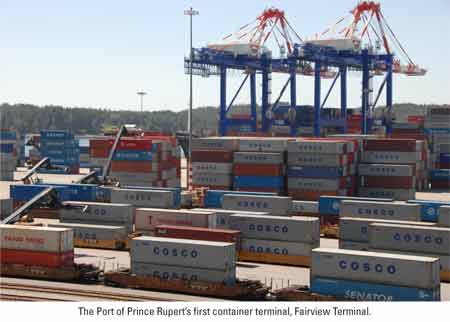
2009 Canada West Coast Ports
By Leo Quigley, AJOTPORT OF PRINCE RUPERT
The Port of Prince Rupert experienced a 53.7% surge in traffic in the third quarter of 2009, posting a 15.9% increase in cargo tonnage for the nine months ending September 30, compared to the same period in 2008. Throughput at all terminals totaled 9,001,286 tons to date compared to 7,766,575 in 2008.
Increases came in grain volumes through Prince Rupert Grain, Ltd. and coal volumes handled at Ridley Terminals Inc.
Barry Bartlett, port spokesman said: “The Port of Prince Rupert is on track to surpass the 10,596,863 tons handled in 2008.”
The port’s first container terminal, Fairview Terminal, moved 180,617 TEUs for the nine months ending September 30, representing a 70.81% increase over the same period in 2008.
“Our third quarter container volumes are a true test of our performance and the competitive advantages that an increasing number of shippers are realizing in moving their products through Prince Rupert,” said Don Krusel, President, in a statement. “The performance is a real testament to the dedicated and committed workforce at the terminal, and the collaboration between all partners, in making the Prince Rupert Gateway a success.”
Throughput at Prince Rupert Grain to September 30 was up 46.8% to 3,966,627 tons, surpassing the 3,759,517 tons handled for the entire 2008 year. The high volumes were driven by wheat exports, up 77.1% to 3,648,906 tons.
Ridley Terminals Inc. (RTI) benefited from the recovery in world metallurgical coal markets and handled 1,619,386 tons during the third quarter, accounting for more than half of the 3,028,110 tons handled by the terminal to September 30.
Bartlett said that while overall tonnage was down 21.9% compared to last year, the current strong global demand is expected to continue. In addition, RTI’s biggest customer Western Coal has announced plans to increase coal production at its northeastern BC mines from 2.2 million tons to 10 million tons annually by 2013.
The port’s sole railway line, Canadian National Railway, also announced, on October 2, that it had ordered 70 new high-horsepower locomotives from GE Transportation, a unit of General Electric Co. (GE), and Electro-Motive Diesel, Inc. (EMD).
In a statement the company said the new GE and EMD locomotives would be equipped with distributed power (DP) capability. DP enables remote control of a locomotive or locomotives throughout a train from the lead control locomotive and will provide faster, smoother train starts, improved braking and lower pulling forces at the head-end of a train, which will enable CN to run fewer and more efficient trains.
PORT OF VANCOUVER
Jim Belsheim President of Neptune Terminals, located on Port Metro Vancouver’s North Shore, recently announced plans by Canpotex – Canada’s potash transportation logistics company - to invest C$37.5 million dollars to double the capacity of the company’s potash handling facility.
In making the announcement Belsheim said the expansion would increase the termina’s throughput speed and provide Canpotex with an additional 1.5 million tons of capacity to export the plant nutrient.
“This investment by Canpotex will allow us to better service the Pacific Gateway,” he said. “We are proud to see such investments which help support shipments of Canpotex’s potash products to international markets.”
The project is expected to take 18 months to complete and will include improvements to terminal conveyor and material handling systems.







